The Royal Game of Ur
This is my interpretation of this ancient board game. Enjoy. To play again you need to re-load the page. And my ajax routine will be saving moves so that I can train a neural-network to choose the best moves when playing against the computer. At present, the logic is relatively simple. (It's also disabled because my hosting doesn't provide the services I need for this without my paying, which I'm reluctant to do at present.)
Nearly everything about the play can be customized by all the menu options in the "Rules and Options" pop-up form.
| |
|
The Royal Game of Ur
Rules
I've pieced together what are likely to be the rules, but I could easily be wrong about these. I've noted why I think these are correct, and given the players a choice to change these to match the ideas put forth by others.
The players start with all their pieces off the board. The dice are rolled, and each player attempts to enter their pieces onto the board and through the path and then off at the end of the path. It's a "race game".
When the dice are rolled, the player may move one of his (remaining free) pieces. Pieces on the board may attack (land on) the pieces of the opponent, causing them to be taken off the board and back to their starting position (similar to backgammon). Pieces that successfully traverse the path over the board are removed from the game. The first player to get all his pieces through and off the board is the winner.
There are several options below to control the complexity of the game. These include variations on the path across the board, optional functionality when landing on or passing over certain tiles, and leaving the board. The board tiles themselves might have had more significance than I describe here, but I'm too cheap to buy the one book I've seen that discusses that topic.
Options
Choose the path across the board. The first one has the most complexity, and the fourth one is what I saw someone else had implemented (a museum). I suspect the first one (or perhaps the second one) was the official one, partly because the "Extra Turn" tile occurs every 4 squares and the first two paths make use of this throughout. The fourth one is the least likely to have been the official path through the board. This one leaves me with no good explanation for the unique tile at the exit for the second path.
Choose which color goes first, and which one (or none or two) is automatically controlled by the JavaScript. It's possible to have the computer play against itself by having it control both colors.
Tile Options
Choose the options associated with the different tiles. This is where the next level of complexity arises. A very simple game for beginners could be played by removing all these options.
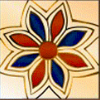
Extra Turn
Land on this tile and receive an additional turn. If you roll 4 repeatedly, you can traverse the entire board (full path); of course, the chance of doing this is (1/16)^6. Or 0.000006% (or in scientific or engineering notation 6e-6 the Sumerians did like the number 6!)
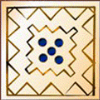
Promote Piece
Cross this tile and be promoted (piece is flipped over and has additional markings). This is required when playing the path(s) where you traverse tiles more than once. A promoted piece behaves exactly like other pieces, but a non-promoted piece may not attack one that is promoted. This option really only applies to the third path through the board.
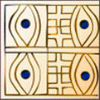
Stack Same
Stack up to four of the same colour on this tile. This appears to be the meaning of the image on the tile. Whatever colour gets to this tile first may claim it for that colour until they move off and let the opponent occupy the square. As a variant; having only one piece on this tile may or may not be safe from attack, but two or more are always safe.
Stack Safe
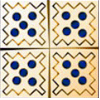
Stack Any
Stack up to four of either colour on this tile. It's possible to detain an opponent on this tile, as only the top piece may move.
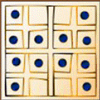
Promote Safe
A promoted piece on this tile is safe from any attack. This unique piece looks to me like the place where the player leaves the board, but it could have other meaning.
Play Options
Exact Number Exit
Require the exact number for leaving the board.